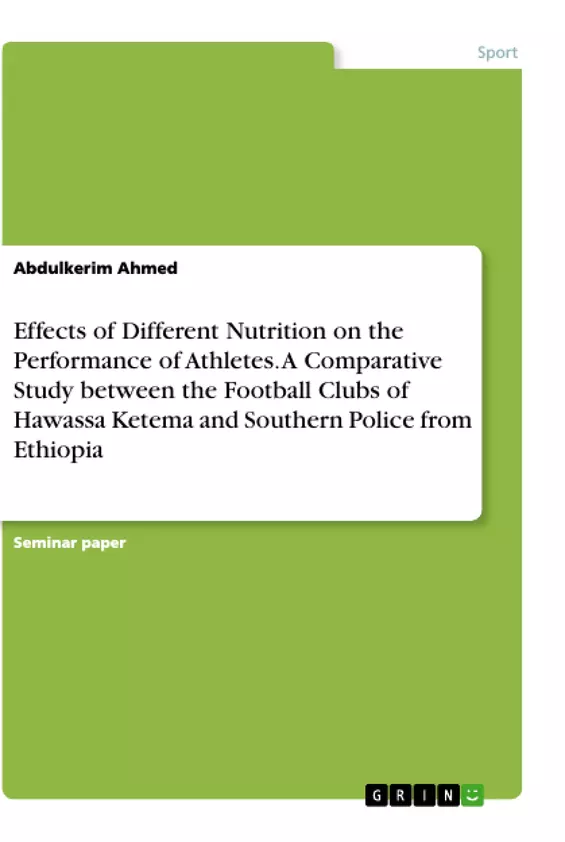The reason why the researcher selected these two clubs is that both clubs are found in Hawassa, they enjoy the same environment, they play their home game on the same pitch, and the only difference that exists between the two clubs is the way how they feed. South Police feeds in the camp while Hawassa Ketema feeds in the hotel. So the researcher wants to know how it affects them. Hence, this study was attempted to answer the following basic research questions. First: What are the daily calorie intakes of the players? Second: What are the major types of diets consumed? Third: Is there a balance between caloric intake and caloric expenditure? Fourth: Do age and body weight of the players is taken in to consideration in the dietary intake?
So far no Ethiopian research on the diet and performance of Ethiopian premier league clubs particularly regarded the aspects of nutrition. In Ethiopian premier league history a number of clubs struggled hardly to stay on the league, unfortunately they relegated to the super league on the same year due to different reasons. Majority of the players and coaches are heard when blaming the referee, pitch, training strategy, game tactics, individual technics and weather conditions to lose the game. No one cared about the effect of diet on the outcome of the game. However, like physical training program, if each and every club intended to follow appropriate nutrition program for their players, the expected result would be remarkable.
It is clear that nutrition has an effect on sports performance. Sport nutrition is a rapidly growing field and is the science of improving sporting performance by tailoring specific food and fluid recommendations to an athlete. It is known that factors such as dehydration and a lack of energy supply can limit performance. As expressed in Foundation Soccer Coaching Manual, nutrition is an important part of any successful training program. Food is the fuel of athletic performance. Though the coach cannot control his/her athlete's food, rather he/she can guide them toward healthy eating. For this purpose, the coach should be acquainted with the basic of proper nutrition.
Inhaltsverzeichnis (Table of Contents)
- Abstract
- Dedication
- Biographical Sketch
- Acknowledgements
- List of Tables
- List of Figures
- Chapter One: Introduction
- 1.1 Background of the Study
- 1.2 Statement of the Problem
- 1.3 Objectives of the Study
- 1.3.1 General Objective
- 1.3.2 Specific Objectives
- 1.4 Research Questions
- 1.5 Significance of the Study
- 1.6 Scope of the Study
- 1.7 Limitations of the Study
- 1.8 Definition of Terms
- Chapter Two: Literature Review
- 2.1 Introduction
- 2.2 Concepts of Nutrition
- 2.3 Importance of Nutrition for Athletes
- 2.4 Nutritional Needs of Athletes
- 2.5 Nutritional Assessment Methods
- 2.5.1 Anthropometric Measurements
- 2.5.2 Biochemical Measurements
- 2.5.3 Dietary Assessment Methods
- 2.6 Factors Affecting Nutritional Status of Athletes
- 2.7 Nutritional Status and Performance in Athletes
- 2.8 Conclusion
- Chapter Three: Methodology
- 3.1 Introduction
- 3.2 Study Design
- 3.3 Study Area and Population
- 3.4 Sampling Technique and Sample Size
- 3.5 Data Collection Tools and Procedures
- 3.6 Data Analysis Method
- Chapter Four: Results and Discussion
- 4.1 Introduction
- 4.2 Socio-Demographic Characteristics of the Study Participants
- 4.3 Nutritional Status of the Study Participants
- 4.4 Discussion
- Chapter Five: Conclusion and Recommendations
Zielsetzung und Themenschwerpunkte (Objectives and Key Themes)
This MSc thesis aims to compare the nutritional statuses of football players from two prominent clubs in the Southern Nations, Nationalities, and Peoples' Region (SNNPR) of Ethiopia: Hawassa Ketema and South Police. The research seeks to understand the dietary habits, nutritional deficiencies, and overall nutritional well-being of these athletes, considering their vital role in the sport.
- Nutritional status of football players
- Dietary habits and practices
- Prevalence of nutritional deficiencies
- Impact of nutrition on athletic performance
- Recommendations for improving nutritional practices in football clubs
Zusammenfassung der Kapitel (Chapter Summaries)
Chapter One provides the necessary background information, outlining the research problem, objectives, significance, and scope of the study. It also defines key terms used throughout the thesis. Chapter Two delves into the existing literature concerning nutrition and its importance for athletes, including nutritional needs, assessment methods, and the relationship between nutrition and performance. Chapter Three details the methodology used in the study, including the research design, study area, sampling technique, data collection tools, and analysis methods. Chapter Four presents the results of the study, analyzing the socio-demographic characteristics of the participants and their nutritional statuses. It also includes a discussion of the findings, drawing comparisons between the two football clubs.
Schlüsselwörter (Keywords)
This study focuses on the nutritional status of football players in Ethiopia, using a comparative approach between Hawassa Ketema and South Police football clubs. Key terms include nutritional status, dietary habits, nutritional deficiencies, anthropometric measurements, biochemical measurements, football players, athletic performance, and sport nutrition.
- Quote paper
- Abdulkerim Ahmed (Author), 2019, Effects of Different Nutrition on the Performance of Athletes. A Comparative Study between the Football Clubs of Hawassa Ketema and Southern Police from Ethiopia, Munich, GRIN Verlag, https://www.grin.com/document/504084



